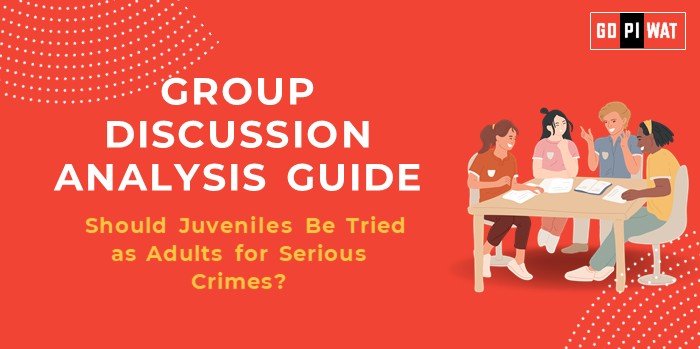📋 GD Analysis Guide: Should Juveniles Be Tried as Adults for Serious Crimes?
🌐 Introduction to the Topic
- ⚖️ Opening Context: Juvenile delinquency is a growing concern worldwide. The debate over whether juveniles should be tried as adults for serious crimes balances rehabilitation and justice, raising profound ethical, legal, and societal questions.
- 📜 Topic Background: Historically, juvenile justice systems were established to rehabilitate rather than punish. However, heinous crimes committed by minors, such as the 2012 Delhi gang rape case, have intensified debates about the age of culpability and the limits of juvenile justice reforms.
📊 Quick Facts and Key Statistics
- 🌍 Global Trends: Over 60% of countries try juveniles under separate systems, with a few exceptions for heinous crimes.
- ⚖️ India’s Juvenile Age: Defined as under 18 years by the Juvenile Justice (Care and Protection of Children) Act, 2015.
- 📉 Serious Crimes by Juveniles: NCRB data shows a 15% increase in juveniles committing heinous crimes in 2022.
- 🛠️ Rehabilitation Success: Countries like Germany report an 80% rehabilitation success rate under juvenile-focused programs.
👥 Stakeholders and Their Roles
- 🏛️ Government: Frames policies balancing justice and rehabilitation, ensuring constitutional rights.
- ⚖️ Judiciary: Interprets laws, decides when juveniles can be tried as adults under special circumstances.
- 📢 NGOs: Advocate for juvenile rehabilitation and against adult trials.
- 👨👩👧👦 Society and Victims: Seek justice while considering the long-term societal impacts of the decisions.
🏆 Achievements and Challenges
✨ Achievements:
- 📄 Justice Reform: Reduced juvenile crime rates in countries with balanced juvenile laws.
- 📂 Case Examples: India’s 2015 Act has increased accountability for 16-18-year-olds committing heinous crimes.
- 🌍 Global Practices: Countries like Norway and Germany prioritize rehabilitation with significant success.
⚠️ Challenges:
- 🤔 Ethical Dilemmas: Balancing justice for victims with rehabilitation for juvenile offenders.
- 🚧 Rehabilitation Gaps: Lack of infrastructure and programs in developing countries.
- 📣 Public Backlash: Cases of leniency leading to reoffending juveniles.
🗣️ Structured Arguments for Discussion
- ✅ Supporting Stance: “Justice must be served; serious crimes demand accountability, irrespective of age.”
- ❌ Opposing Stance: “Juveniles are victims of their circumstances and need rehabilitation, not punishment.”
- ⚖️ Balanced Perspective: “The approach should be crime-specific, blending strict justice with opportunities for reform.”
💡 Effective Discussion Approaches
✨ Opening Approaches:
- 📜 “The Delhi gang rape case forced us to question if age should be an excuse for heinous crimes.”
- 📉 “Juvenile crime statistics show an alarming trend; how do we strike a balance?”
🔄 Counter-Argument Handling:
- ⚖️ “Acknowledging the need for justice, can we explore programs ensuring juvenile accountability without adult trials?”
- 📚 “Rehabilitation successes in Norway offer solutions we might adapt.”
⚡ Strategic Analysis of Strengths and Weaknesses
- 💪 Strengths: Tailored rehabilitation; reduced stigma; ethical alignment.
- 🚫 Weaknesses: Public discontent; potential loopholes in justice.
- 🚀 Opportunities: Public-private partnerships for reform programs.
- ⚠️ Threats: Escalation of juvenile crime due to leniency.
📚 Connecting with B-School Applications
- 🏢 Real-World Applications: Topics like corporate ethics and restorative justice link to managerial dilemmas.
- 🤔 Sample Interview Questions:
- 📜 “How should a society decide on punishment vs. rehabilitation for minors?”
- 📚 “Can the corporate world learn from juvenile justice systems in fostering inclusivity?”
- 💡 Insights for Students: Explore CSR initiatives linked to juvenile rehabilitation programs.


